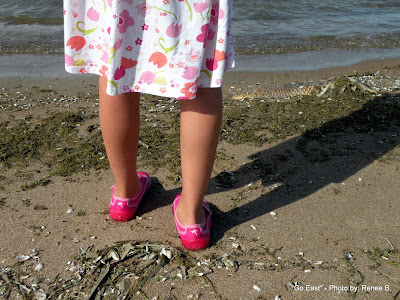(A part two of the original rewind post "Fun with Nature #23" - beach time in winter including the sharing of my 24 best beachcombing tips with you below.)


Believe it or not, the word "beachcomb" was invented between 1830-1840 when one person decided to place "beach" and "comb" together to form a new word. Soon popular, the dictionary meaning for such a word is;
 beach . comb . er ( beech-koh-mer)
beach . comb . er ( beech-koh-mer)
a noun
- 1. a person who lives by gathering salable articles of jetsam, refuse, and other items from beaches.
- 2. a vagrant who lives on the seashore.
- 3. a long wave rolling in from the ocean onto the beach.
There is something very refreshing about a trip to the beach, either for an hour, a day or for a vacation.
People head to the beach for a variety of reasons; for exploration, exercise or relaxation. This is how I would describe a beachcomber myself, for it is during an exploration timing that one might find treasures washed up along the seashore.
Beachcombing is a family favorite, something we've done for years and years, something our older children continue to do with their own children.


During vacations beachside, typical mornings would be spent walking the endless miles along the beach when the tides were out. We would explore, run, and locate various items of interest, certain to always find some new treasure deemed worth keeping to return home with us, forever.
The ocean treasure collection appetites were often whet to the point of continued study once home again, and many a collection has appeared in handmade sorting boxes, all cleaned and often labeled with our very proud children standing near, always eager to share their finds with an audience.


Sharing my *24* best beachcombing tips with you;
- Wear a hat and sunscreen for sure!
- -1- Dress properly if you know you'll be exploring for a while.
- Wrap a hoodie around your waist for it's always windier at the ocean side.
- Wear glasses to diffuse the rays of the sun when they begin to bounce off the water.
- Be smart.
Many a sunburn cometh from the water's edge. And sunstroke. And wind burns.
And if not dressed for water's wetness, there are brothers who just might decide it's time for you to enter the water at some point when least expected. Oh dear. I wonder if she's ever forgiven him to this day for that one. :)and older sister about to be also.
- -2- Since beachcombing is an art of finding great treasures along the water's edge, many which are keepsakes, nothing found should ever be kept if it is alive.
- -3- Always bring along a few ziplock baggies, keeping them in your pocket for surely a young one will find too many treasures to keep inside of his sweet little cupped hands. Your pockets will thank you for being prepared with these treasure keepers, they will. Many a sandy and slimy pocket has returned home here for this mama, so in the past few years, I'm always prepared with treasure keepers.
- -4- Bring along a mesh bag for easy clean up to beach bag items; shovel, nets, bottles with lids, rake, mesh catcher, bucket, strainer, watering bucket, the works! Throw everything back in the mesh bag, pull the toggle tight and swish about in the water to rinse the sand and salty smell away. Easy.
There is real gold to be found at the beach, and not only for pirates, be it coins, jewelery, artifacts or precious gems located around rocky edges of the bottoms of cliffs.
- -5- If you spot a real treasure comber with his metal machine device in hand, in or out of the water hunting for metal items, stop and observe what he might find. Our oldest son was shocked and astonished when his wedding ring fell off on the shores of Oahu, Hawaii three years ago. Maybe a treasure hunter found it by now.
This beach is in the "Baja" of Mexico
(Respect the ocean and especially the tides for they can become wild and furious.)
- -6- Learn from others. Once while beachcombing around the beaches of Parksville on Vancouver Island, we stumbled upon a man thick in a one-sided conversation, a man who was offering his vast naturalist knowledge to another family with regards to the tidal pool and the many jelly fish and starfish located there. We hovered near and pardoned our interruption, requesting politely that we be included in the friendly chat. He was so knowledgeable and we came away with a whole new appreciation for seasides and oceanography in general.
- -7- Best times for beachcombing treasure hunts? This would be directly after the calming of a storm or shortly after the tide comes in for the waters have churned hard and treasures become loosened in the waters.
Recovering at the beach the day after our
oldest son and new daughter were married.
Ready to dig in for the entire afternoon and evening!
- -8- When the tide begins to pull back and roll out to sea, scout down low to observe wee crabs walking sideways, and note active holes with blowing bubbles. An ocean animal is digging lower into the sand for protection.
- -9 - During low tide, look for small puddles, perfect for locating sand dollars and star fish. They must be white (dead) in order to keep them, never black or green please.
Bring one along in a ziplock bag in a napsack if possible.
- -10- Watch when sporting bare feet not to walk upon moon jellies on land, sharp crustaceans roaming for cover and other assorted items. Be safe and buy water shoes, or another waterproof shoe for beachcombing walking pleasures.
- -11- Careful never to disturb marine life at the water's edge, or in tidal pools. If you find a tidal pool, be careful there. Continue to discover, admire, touch and feel but taking care to keep nature as it should be.
At the beach, wash the salty sand or seaweed residues off each piece before entering your vehicle and heading off for home. Then if one of your loved ones happens to forget one inside of your vehicle, you'll thank me for this tip. (LOL)
- -12- Most popular at beach shores are finding seashells; univalves and bivalves. Many shell collections have entered our home, but first, be sure you carry with you no live animal inside the shells.
When arriving at home, find yourself a large pan and fill it with all your shells and boil them for about 20 minutes.
Notice the colorful surfaces appearing? Have a shell identification book on hand, find the names of those you brought home.( First - Be sure to check out the warnings if the water is contaminated at present before eating any shelled creature from the ocean)
- -13- Other items of collectible interest are rocks found along rocky edges (moonstones, jade etc.), feathers, or find out how fun and exciting it is to become a clam digger. It's hard work, but all one requires is a large bucket and shovel, or many hands.
- -14- Respect the ocean. Keep it free from your snacking garbage, food stuff, tissues, plastic treasure bags forgotten, or other items of concern. Learn about ecosystems and how to keep them free from harm.
- -15- If you have a bonfire on the beach, always clean up after yourself, same as for picnics of any kind. Happy is the family who does not leave their footprint behind.
The ONLY time they drank cans of sprite, the time when it was the only thing to keep some hydration rolling. Now water is our hydration preference. I often thought this would make a great advertisement for the company...LOL
- -16- Bring your treasures home and either display them, identify what you have if unknown, or make some nature crafts with them for keepsakes or gifts.
- -17- Don't save beachcombing only for summer. Visit the water's edge during each season of the year. Yes, even in winter. Note the changes happening there from season to season. Keep a nature notebook or nature shelf at home and keep your treasures from a day a the water's edge on display there.
- -18- Visit the water's edge at various times of the day. Be sure to run about during low tide, twice each day on the ocean's edge. Observe the tides, both low and high. Learn more about tides, the pull of gravity and offer checklists to your children for not getting caught in it when it's heading back out to sea. Check your calendar if it notes the tides for each day.
- -19- Be sure to catch a sunrise AND a sunset with your children, at least once each during any given season. Where is the sun located in fall or winter when the sun sets? How about in summer and spring? Why is that? Check out the time of day for when the sun rises and falls while walking on the water's edge. Note it in your nature notebook. Be there on purpose during that time of day.
- -20- While at a lake, or pond, check the water's edge for evaporation or sudden pollution or erosion. What could be done to clean up the water? Bring along a bag and have your family make a general clean up of your favorite area, gathering garbage and items which could harm the area if left where they don't belong. Adopt your spot!
**Play games while on your excursions to the water. "I Spy" is fabulous. Be prepared with ideas for a scavenger hunt, sandcastle making when the roaming explorations are complete and always remain open to new possibilities for further study later on once home again.
**Weather means much when visiting a water's edge for obtaining the best experience possible. However don't shy away from a foggy start to the day when the weather man promises sun.
Our best times sitting at the early morning water's edge has been in the midst of fog, without really good visibility, sipping a cuppa something hot, wrapped in a blanket to remain warm and slowly waking with the promise of both daylight and sunshine. (bring extra clothing all the time just in case a change is required)
Our best times have included walking in snow and noting the crust of ice on the shores. Wear mitts and good boots to keep warm.
Our best times too have been visiting after huge storms and walking about log drifts and an abundance of seaweed. Bring a bucket, treasure bags and a shovel.
Oh yes, visit the shores of the water's edge soon. You'll have no regrets.
- 21- Mothers - take your young babies to the beach! No matter the season, a hat is a must, and maybe something to keep them warm and protected from the wind. I used to use a snugli with my wee ones. A backpack is also good to allow for free hands.
Happy a mommy who's baby obtains great fresh air for she too will find the same refreshment beachcombing.This is a fun activity when the tide is moving in and yet it's still shallow enough for mom or another to walk with rope in hand. The children can hold nets to pick up things in the water, perhaps a fish?
- -22- Like the water's edge? Have young ones? Why not step out and take your young ones walking along the shore while bobbing up and down on the waves in a small rubber dingy?
A bucket can serve as bailing out the boat when someone dumps a water load inside many times. Also a great idea for a mother to many young ones, they'll all love it.
- -23- Like the water's edge more than this, and the temptation to get under the surface for exploring even more? Then meet my son who has eight scuba diving certifications so both he and his wife can get under for even more ocean exploration together. Who would have thought all those Jacques Cousteau books and videos would have resulted in this?
However, the temptation arises to share a real pet peeve of mine with ya'll. The water's edge is the place where one typically finds parents distracted for one reason or another with wee ones running about precariously near the water's edge, in the depths of water higher than their heads or within deep sea puddles. Many a child who has drowned at the beach!
- -24- Happy is the parent who can allow their children the romp of the beach when the tide is out. What a great place to visit with wee children! How fun it is to know they are obtaining fresh air, and getting fabulous playtime exercise at the same time.
** Parents - please, please, PLEASE (!) protect your children and one of the very best ways to do that is to watch them.
If you are the parent of many young children, start scouring thrift stores and garage sales for lifejackets (pdfs) and snap them on your wee ones for extra protection for when you aren't able to have hawk eyes on all of them at once. It's a small price to pay for peace of mind!
And besides there aren't always other older mothers lurking about willing to watch your children FOR YOU like I do most often, for it has (involuntarily) become my duty when almost witnessing near drownings far too many times.
Don't get me wrong..... for I am always happy to help another, especially a mother who is busy with many children. They are not usually the ones in which I speak of. Rather the ones who sit with a good book and tell their children to go off and play, never raising their heads to see where their own wee ones might be, even if in danger - those are whom I speak of.Finally, this post has concluded my summer beach in winter writings.
My hope is even in winter, you've possibly considered bundling up and heading off to the water's edge soon yourself with your bunch.As always, you can find more "Fun with Nature" posts by clicking HERE to read the others in this category. Enjoy!





.jpg)























